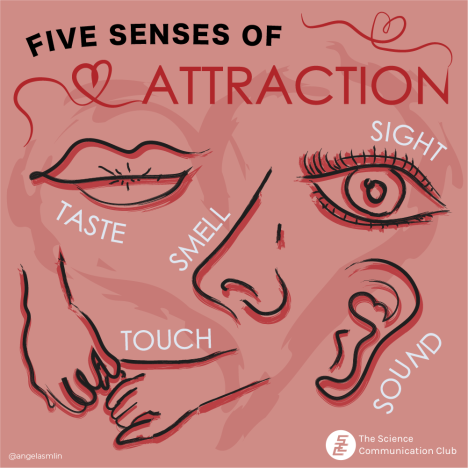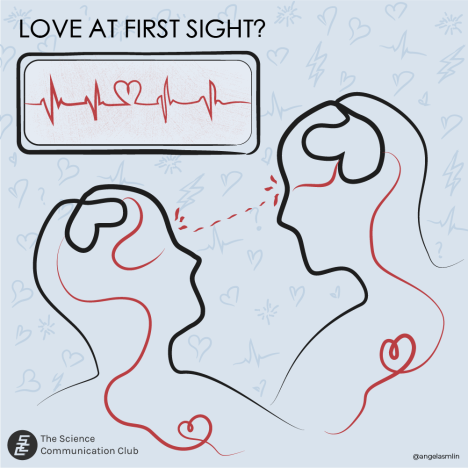
Written by Ava Harrington
Illustrated by Angela Lin
This article is part of our Special’s Week series, The Science of Romance.
You may have heard about “love at first sight,” but what about “love at first smell?” When we meet someone new, our five senses work to synthesize the information we encounter to see whether they might be a potential mate. Our senses can inform our attitudes in surprising ways. In this article, we discuss some interesting studies related to each of the five senses and how they contribute to romantic attraction.
Sight
Love at first sight describes strong initial attraction between two people when they first see one another, and scientists have attempted to probe the biological signals behind this experience. One study used electrocardiography to measure electrical heart signals of participants when exposed to images of various faces. It was found that when shown attractive faces, a change in physiological signals measured by the electrodes indicated a potential bodily reaction of the love at first sight experience. A similar study found that when exposed to images of their romantic partners, participants experienced higher heart rate, facial expression change, and even higher electric conductance of the skin. Our brain translates what we see into how we feel about potential partners.
Sound
Sound is another important component that allows our brains to make sense of love and attraction. Several studies have identified a relationship between both vocal tone and pitch in feelings of attraction. One study found that when speaking to an attractive person, people tend to lower the pitch of their voices as compared to speaking to others. When another person listened to recordings of this speaking, they claimed that it was more attractive than when the person was speaking to someone they were not attracted to. suggesting that this change in pitch actually does influence others’ attraction to us. Beyond voice, there are also other roles for sound in our understanding of attraction. Researchers have long been curious about the evolutionary origins of music, and a new study suggests that it may be for attraction. The researchers played high- or low-arousal music for some female subjects, and played no music for others. Then the participants were shown images of various faces. Women who had listened to high-arousal music rated the faces as more attractive than those who had listened to low-arousal or no music. These studies indicate that our brain integrates our sight and sound senses in order to make sense of our attraction to others.

Smell
You may have heard of bugs, cats, and other animals finding mates through pheromones, or smelly chemicals which transmit information about animals to one another. Although you may not seem to sense the smell of others, several studies suggest that humans similarly produce and perceive pheromones that influence attraction. In one study, the experimental group participants were given a mask containing human pheromones, while the control group wore a mask without the scent. Participants were asked to describe the attractiveness of various images. Compared to participants who hadn’t smelled the pheromone, those exposed to the pheromone reported the people in the images as “sexier”. A different experiment demonstrated that women who repeatedly smelled human pheromones were more likely to engage in conversation with men the following day. Like other animals, our nose helps us sniff out a potential mate.
Taste
Some have suggested that food is the way to someone’s heart, and science suggests that this saying may be more fact than fiction. A study determined that participants who ate sweet rock candy processed language in a different way, specifically by finding certain words more romantic and emotionally influential than those who did not have the candy. A similar study found that participants who ate cookies or drank soda would evaluate a hypothetical relationship more positively than those who ate chips and drank water. It seems that love really is sweet!
Touch
Touch is very important for feelings of attraction. In one study, pairs of strangers who were directed to silently touch one another had significantly higher heart rates than strangers who only made prolonged eye contact. Touching also led to more positive moods and greater willingness to be re-paired with the same partner. Another study which investigated willingness to play romantic video games similarly found that participants were more eager to play games that involved virtual touching. Even the idea of touching is enough to inspire romantic feelings.
When we meet someone new or even interact with a long-term partner, our bodies integrate many sensory signals in order to influence attraction and improve moods towards a loved one. Love can happen at first sight, but it can also happen with sound, smell, taste, and touch!
Sources
- Zhang J, Yuan G, Lu H, Liu G. 2021. Recognition of the Impulse of Love at First Sight Based on Electrocardiograph Signal. Computational Intelligence and Neuroscience. 2021:e6631616. https://doi.org/10.1155/2021/6631616.
- Vico C, Guerra P, Robles H, Vila J, Anllo-Vento L. 2010. Affective processing of loved faces: Contributions from peripheral and central electrophysiology. Neuropsychologia. 48(10):2894–2902. https://doi.org/10.1016/j.neuropsychologia.2010.05.031.
- Hughes SM, Farley SD, Rhodes BC. 2010. Vocal and Physiological Changes in Response to the Physical Attractiveness of Conversational Partners. Journal of Nonverbal Behavior. 34(3):155–167. https://doi.org/10.1007/s10919-010-0087-9.
- Marin MM, Schober R, Gingras B, Leder H. 2017. Misattribution of musical arousal increases sexual attraction towards opposite-sex faces in females. Papadelis C, editor. PLOS ONE. 12(9):e0183531. https://doi.org/10.1371/journal.pone.0183531.
- Kirk-Smith MD, Booth DA, Carroll D, Davies P. 1978. Human social attitudes affected by androstenol. Research Communications in Psychology, Psychiatry and Behaviour.
- Cowley JJ, Brooksbank BWL. 1991. Human exposure to putative pheromones and changes in aspects of social behaviour. The Journal of Steroid Biochemistry and Molecular Biology. 39(4, Part 2):647–659. https://doi.org/10.1016/0960-0760(91)90264-6. https://www.sciencedirect.com/science/article/pii/0960076091902646.
- Wang L, Chen Q, Chen Y, Zhong R. 2019. The Effect of Sweet Taste on Romantic Semantic Processing: An ERP Study. Frontiers in Psychology. 10. https://doi.org/10.3389/fpsyg.2019.01573.
- Ren D, Tan K, Arriaga X, Chan K. Sweet love: The effects of sweet taste experience on romantic perceptions. https://doi.org/10.1177/0265407514554512. https://journals.sagepub.com/doi/pdf/10.1177/0265407514554512.
- Williams GP, Kleinke CL. 1993. Effects of Mutual Gaze and Touch on Attraction, Mood, and Cardiovascular Reactivity. Journal of Research in Personality. 27(2):170–183. https://doi.org/10.1006/jrpe.1993.1012
- Koike M, Loughnan S, Stanton SCE, Ban M. 2020. What factors attract people to play romantic video games? Manalo E, editor. PLOS ONE. 15(4):e0231535. https://doi.org/10.1371/journal.pone.0231535.